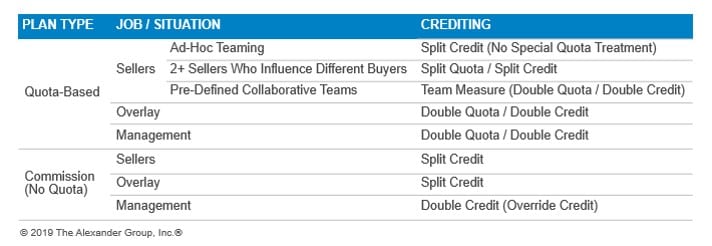TEAMING: Finding Justice in Credits and Splits
Solution selling is the name of the game for most media advertising sales companies. In an ever-changing media landscape, sellers must sell innovative solutions to be inclusive of new revenue streams that help their customers achieve their business goals. Consultative solution selling requires sales resources to effectively team together.
Teaming Situations
Over 100 media sales compensation leaders at Alexander Group’s recently held 2019 Media Sales Comp Symposium shared teaming scenarios that they have had to address during their sales compensation planning. They include the following:
- Core Seller (AE) paired with a Hybrid Sales/Service Job (AM)
- Hunter Seller and Farmer Seller
- Agency Seller and Advertiser Seller
- Holding Company Lead with Core Seller(s)
- Global/National Account Lead with Core Seller(s)
- Core Seller and Specialist Seller(s)
- Core Seller and Programmatic Seller
- Multiple Specialist Sellers
- Category Pod Sellers (multiple sellers focused on an industry category)
And to further complicate matters, most media sales companies are using several of these teaming scenarios.
Challenges
A recent CRO summed up their challenge appropriately: “We need our people to work together. We also need to drive accountability. How can we accomplish these sometimes diametrical goals?” Sellers will either complain or not support a sale if they are not getting any (or enough) credit. However, when using team quotas, the quotas become so big that it is hard to recognize and reward the true stars.
Operational challenges include higher-level ‘galactic’ goals when there are not enough resources or an inability to track sales at a more granular level (e.g., using a region as opposed to account goal). Some challenges reside with poor job and territory design management practices. Some companies have not clarified the job roles and the rules of engagement, leading to double credit. Other companies have not done a good job at assigning the right accounts to the right resources and managing assignments when reps join/leave, leading to many reps getting credit. Lastly, a few companies may provide ‘appeasement’ credit to satisfy complaining sellers.
Solutions
Wherever possible, use individual measures that drive accountability. However, remember that companies can also drive individual accountability applying the right coverage model, clarifying the job roles, ensuring enough resources and defining the right territories. Only use team measures for collaborative work team (e.g., AE and AM teams) and overlay resources (specialist and holding company leads). If needed, use team measures for resource constraints and hard to track measures for a limited time. Consider split quotas and credit for pre-defined selling scenarios where sellers focus on different buying points (e.g., agency vs. advertiser). Lastly, split credit (with no split quota) ad-hoc teaming or pure commission plans. The exhibit below outlines the typical crediting practices by job/situation and plan type. 100% commission plans must use split credits to prevent run-away costs and therefore is not the optimal mechanic for organizations focused on complex solution and team selling.
Exhibit: Typical Crediting Guidelines

Conclusion
In summary, best-in-class practices include clarifying coverage, job design, rules of engagement, and account assignment practices. Align measures/crediting rules to the job’s role within a team. Pay for persuasion (not service or activities that do not drive revenue). In addition, do not use the plan to replace poor performance management practices.
Is your company having challenges driving the appropriate teaming and accountability?
Alternatively, are you interested in learning more about sales compensation trends, insights and best practices gleaming from our recent Media Sales Comp Symposium? If so, contact an Alexander Group Media Sales practice lead.
_______________________________
RELATED RESOURCES
